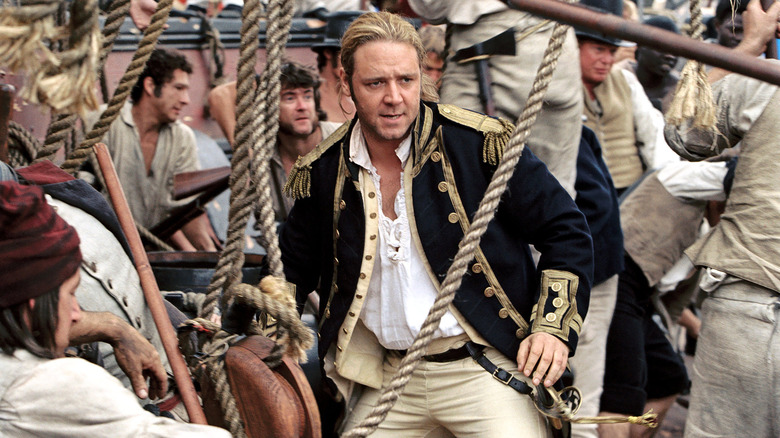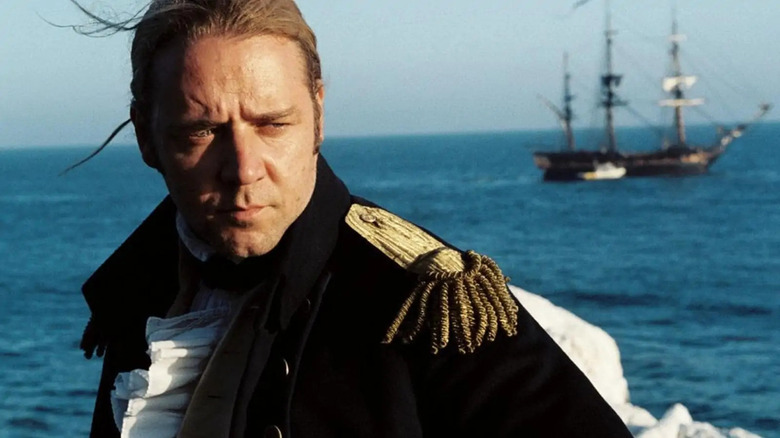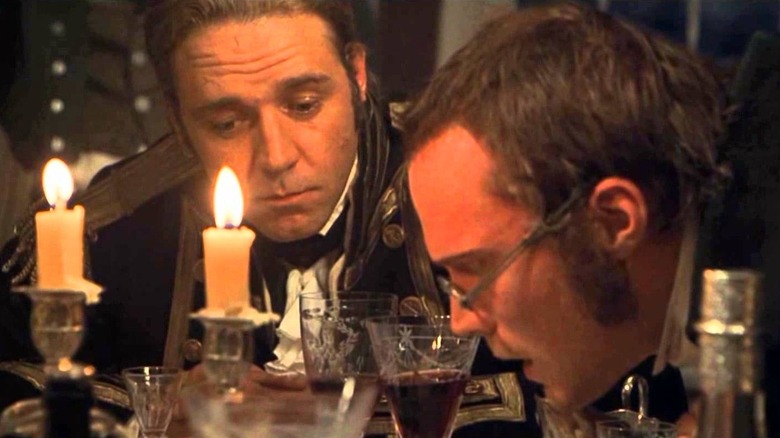Master And Commander Borrowed An Important Piece Of Tech From Titanic
It was only because of the release of a certain fantasy film that Peter Weir's "Master and Commander: The Far Side of the World" failed to win the Academy Award for Best Picture in early 2004. Based on a series of novels by Patrick O'Brian, "Master and Commander" depicted a several weeks aboard the HMS Surprise, an English warship during the Napoleonic wars. The Surprise was commanded by Capt. Jack Aubrey (Russell Crowe), and whose medical responsibilities were led by Dr. Stephen Maturin (Paul Bettany). The relationship between the rough-hewn, professional Aubrey and the meticulous and scientific Maturin, served at the film's emotional core amid several cannonball battles, a desperate search for resources, and other ship-bound crises. "Master and Commander" is impeccably made and, like the novels that inspired it, deeply preoccupied with accurate period detail. I also has Luigi Boccherini's La Musica Notturna Delle Strade di Madrid, No. 6, Op. 30 in it, and that's a surefire win.
The production of "Master and Commander" was, as one might imagine, an immensely difficult one, and recreating a maritime warship was a painstaking special effects process that involved models, the clever use of CGI, and a slow, steady rocking of the camera to give the viewer the impression of the sea's natural heaving and exhaling.
In a breakdown for the DGA in the fall of 2005, Peter Weir went over some of the film's resplendent visuals, and detailed some of the techniques and unique equipment used to shoot several of the ocean sequences. Luckily for Weir, he didn't need to build a contained body of water to shoot in, as a 20 million gallon tank had already been constructed for James Cameron's "Titanic" six years earlier.
The Super Techno crane with a three-axis head
The tank for "Titanic" was constructed in Rosarito, Mexico, where Cameron had a full-scale model of the title ship built. While most of the on-deck scenes in "Master and Commander" were filmed at sea on a replica of an 18th-century vessel called the HMS Rose (currently on exhibition at the San Diego Maritime Museum), the wide exteriors of the ship were filmed in the tank. The tank had been equipped with a crane arm, which Cameron had also used to get long, sweeping shots of his Titanic model. The crane was left intact. In addition to the seaworthy ship, and the model used in Mexico, the Weta Workshop also built a scale model for storm sequences.
Weir, in the DGA interview, went through many of the ship shots, recalling how they were achieved. For one, he recalled that it was:
"[S]hot in the tank in Baja from a Super Techno crane with a three-axis head mounted on a barge. This was a primary piece of equipment during the whole shoot because it was so wonderfully useful for creating the up-and-down movement of a vessel at sea. So we backed that up as far as we could, to probably some 600 feet from the stern of the English vessel, and on the call of 'action' we moved forward and approached at a speed that we calculated would photographically feel right. We shot at dusk for dawn and what you see is all photo-real with the exception of the rigging."
For the wider shots of two separate ships at battle — the Surprise has an archenemy in the French ship Acheron — miniatures were used:
"The two ships are miniatures shot separately on dry land in New Zealand, as all the miniatures were, and composited into the ocean by ILM. It was a very, very tricky shot to get right. We had problems with scale. Then there were problems with the water. We had to slow vessels down and would speed them up on another take. Then it seemed it was all taking too long. What helped was the decision to pan right to left and trek back with the camera, enabling the enemy vessel to come in quicker. I wanted a feeling of stalking and to feel the weight of the enemy vessel and its power."
400 pounds of hair
The ships weren't the only thing Weir wanted as accurate as possible. The elaborate military uniforms worn by both officers and enlisted men were all made by hand, including handmade caps that were, according to the press materials knitted by "a lady in Wales" using 200-year-old wool. From those same press materials, we learn that over 400 pounds of hair were glued to the cast. All of these things were destined to be soaked during the film's many wave and splashing sequences. Luckily, thanks to "hydroflex water bags," the cameras were kept dry.
And interesting piece of trivia: "Master and Commander" was the first non-documentary film to be shot on the Galápagos Islands.
When "Master and Commander: The Far Side of the World" was released, it was met with overwhelming critical acclaim (a nose-holding review from the phlegmatic Christopher Hitchens notwithstanding), but, according to Weir, didn't have quite the opening weekend the studios wanted, and another film with Jack Aubrey and Dr. Maturin was never put into production. A sequel made perfect sense, given that there were 20 completed books in O'Brian's series.
It was finally announced in June of 2021, however, that another Aubrey/Maturin film is in the works, although it will not involve Weir, Crowe, or Bettany. Peter Ness ("A Monster Calls") will direct, and new, younger actors will play the parts. While this isn't exactly what fans of the original wanted, it will, perhaps, do. It is, after all, better than nothing and, as Lucky Jack Aubrey taught us, we must always choose the lesser of two weevils.


